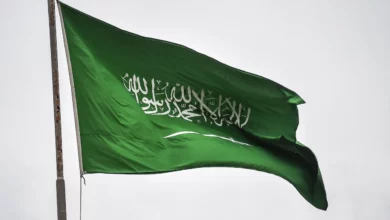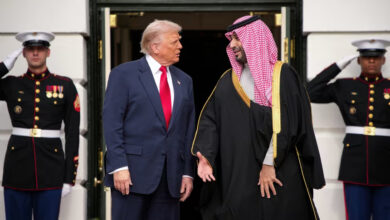
The Edge of Arabia group, a loose coalition of contemporary artists from Saudi Arabia, has birthed a powerful and experimental contemporary art movement in just a few years. The narrative of the group’s inception is poetic in its simplicity. As it is told, Edge of Arabia emerged by gathering together myriad isolated artists dispersed across the country and connecting them together like the disparate stars of a constellation.
While there have been artists working in Saudi Arabia for years, Edge of Arabia connected those artists and made Saudi contemporary art visible for the first time both inside and outside of the country.
Ten years ago, founding curator Stephen Stapleton was traveling through the Middle East with several other British artists. In Saudi Arabia, the group found their way to the al-Meftaha Arts Village. Stapleton was intrigued by the work of the artists he met there, including Abdelnasser Gharem and Ahmed Mater, two stars of the Edge of Arabia group.
Stapleton told Egypt Independent, “The backdrop was the invasion of Iraq, the internet, post-9/11 and a heightened emotional sense. There were many things happening, and it was like walking into a big experiment. They were breaking out of their canvases in all sorts of weird, wonderful ways.”
The combination of formal experimentation and a bold engagement with contemporary social and political issues continues to define the Edge of Arabia group, which has attracted attention at the highest levels of the international art world, and met exceptional success on the art market. Last year’s record-breaking Christie’s Dubai sale was driven in no small part by interest in Edge of Arabia artists.
After Stapleton met Mater and Gharem, they began moving around the country together, meeting artists like Manal al-Dowayan, who described the beginnings of her involvement with Edge of Arabia to Egypt Independent.
“Ahmed Mater and Stephen [Stapleton] came to visit me. I was in the East here, I was working, and I was quite isolated. I jumped at the idea of actually meeting other artists,” she explained.
That creation of community was both the spark and the enduring strength of Edge of Arabia. Once formed, the group, which is funded almost entirely by the Abdul Latif Jameel Foundation, built its reputation by holding collective exhibitions in the art capitals of the world: London, Berlin, Istanbul, Venice and Dubai.
Earlier this year, Edge of Arabia made a triumphant homecoming with an exhibition in Jeddah that constituted one of the most significant presentations of contemporary art in Saudi Arabia ever. The exhibition, “We Need to Talk,” included the work of 40-some artists and filled a massive space in an upscale development on the Western coast in Jeddah.
The curator of “We Need to Talk,” Mohammed Hafiz, a Saudi gallerist who has been working with Edge of Arabia since its inception, said of the concept of the exhibition, “We wanted to look at the social environment in Saudi Arabia and the world … bringing in this aspect of dynamic discussion that is not necessarily what the Saudi public would expect from an art exhibition.”
The exhibition is marked by forceful artistic statements that carry direct political connotations, but it pays close attention to material and scale, avoiding the potential trap of straightforward didacticism. Dowayan’s “My Name” addresses the tendency for women in Saudi Arabia to be referred to in relation to their male relative’s names rather than their own. To create the work, Dowayan held workshops across the country in which women painted their names on giant prayer beads. In a grand, sweepingly poetic gesture, she hung the beads in chains from the ceiling of the exhibition space.
Mater’s “The Cowboy Code II” juxtaposes a list of rules of the American Wild West beside sayings of Prophet Mohamed on a large red panel composed of caps from a toy gun. The work is filled with political references and metaphorically loaded material, but these pieces do not come together to form any one clear message, hovering instead in an uncomfortable realm of ambiguity.
All of the works in the exhibition passed through a censorship committee, showing that Saudi governmental interference in artistic production can be heavy-handed. Still, the works passed the censors despite their overt political content, and curator Hafiz does not think government control was the obstacle that prevented such a large-scale exhibition of contemporary art from taking place before. Hafiz says, “I think the timing was more related to the readiness of people to see such art.”
He credits growing attention to the arts in other parts of the Gulf with helping to increase public interest in and openness toward contemporary art.
“If you look at the whole region 10 years ago, Art Dubai didn’t exist. The museum in Qatar opened a year or two ago. The art movement was not there, or it was fragmented. The readiness of people to see art was there, but there was not a high level of interest,” says Hafiz.
But the emergence of an art scene in Saudi Arabia has taken a different course from that of its neighbors. Stapleton is quick to point out the differences between Edge of Arabia and the high-profile, high-cost programs that have helped Abu Dhabi, Dubai and Qatar become hubs of the international art world.
“The Louvre and the Guggenheim [planned in Abu Dhabi] might be canceled after billions of dollars [were spent], and we had only hundreds of dollars in the beginning. The Saudi art scene is thriving, and the Emirati art scene is thriving on art from elsewhere,” says Stapleton.
Stapleton hopes the Edge of Arabia model might be a concept that can be exported and replicated elsewhere, saying, “We are an independent, social enterprise … and it is a replicable model. It works to do this kind of searching for artists on the periphery, putting something together under one banner.”
But Dowayan is more skeptical.
“Edge of Arabia as a model is something that looks easy to replicate, but a lot of people have done group shows and not received this amount of interest,” Dowayan said.
She still wonders about how the project came to such international prominence.
“Is it the group that is unique? Is it the vision of Edge of Arabia that is unique? … Is it attention because of the geographical location? Or is it because of the art?” she said.
Most likely, it is a combination of all of these things. Henry Hemming, a writer and arts journalist who accompanied Stapleton on his first journey through Saudi Arabia, gives partial credit to the limitless information and resources available on the internet for making a project like Edge of Arabia possible now.
“Saudi is a very connected country,” Hemming told Egypt Independent. “Gharem, Mater and other artists in Saudi were all reading about contemporary art on the internet and beginning to work at the same time in different places.”
And perhaps it was the very lack of any significant contemporary art history in Saudi Arabia that allowed these artists to come together with such openness, enthusiasm and sense of community. In another place, with established arts institutions and communities of artists, it would not be so simple to summon such a cohesive and successful representation of a new generation of artists.
The strength of that community has no doubt helped individual artists feel supported enough to experiment and work on a large scale.
And certainly, the fact that Edge of Arabia hails from a country as opaque to outside observers as Saudi Arabia has helped drum up international attention. The fact that Saudi is home to a whole class of people in prime position to begin investing in art makes Edge of Arabia particularly attractive to auction houses.
But Hafiz points out, “A good curator, good work, execution of the highest standards … these are general elements that make any art exhibition a success. It is combining those essential elements with elements that are unique to Saudi Arabia, and doing both well, that I think has made this project so successful.”
Edge of Arabia has struck an exceptional combination, and the results are thrilling to watch.





